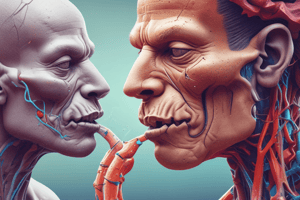Podcast
Questions and Answers
What is the primary function of goblet cells in the respiratory system?
What is the primary function of goblet cells in the respiratory system?
- Transporting mucus out of the lungs
- Filtering air entering the respiratory system
- Producing mucus in the epithelial lining of the trachea and bronchi (correct)
- Facilitating gas exchange in the alveoli
A patient reports having a cough for 6 weeks following a cold. How would this cough be classified?
A patient reports having a cough for 6 weeks following a cold. How would this cough be classified?
- Sub-acute (correct)
- Persistent
- Acute
- Chronic
Which of the following best describes a productive cough?
Which of the following best describes a productive cough?
- A hacking cough that indicates a viral infection
- A dry cough that does not produce any mucus
- A cough that expels secretions from the lower respiratory tract with ease (correct)
- A cough that is not normal for physiologic purposes
What is the primary mechanism of action of an antitussive medication?
What is the primary mechanism of action of an antitussive medication?
A patient is experiencing nasal congestion due to a cold. Which of the following medications would be most appropriate to recommend?
A patient is experiencing nasal congestion due to a cold. Which of the following medications would be most appropriate to recommend?
What is the mechanism of action of phenylephrine as a decongestant?
What is the mechanism of action of phenylephrine as a decongestant?
A patient with a history of hypertension is seeking advice on managing cold symptoms. Which decongestant would be the safest recommendation?
A patient with a history of hypertension is seeking advice on managing cold symptoms. Which decongestant would be the safest recommendation?
Which of the following is a common adverse effect associated with first-generation antihistamines like diphenhydramine?
Which of the following is a common adverse effect associated with first-generation antihistamines like diphenhydramine?
What is the primary use of dextromethorphan?
What is the primary use of dextromethorphan?
Why is codeine not recommended for children?
Why is codeine not recommended for children?
What is the primary mechanism of action of guaifenesin?
What is the primary mechanism of action of guaifenesin?
A patient is looking for a topical antitussive. Which ingredient would be most appropriate?
A patient is looking for a topical antitussive. Which ingredient would be most appropriate?
According to guideline recommendations, what combination is beneficial for treating acute coughs associates with post nasal drip?
According to guideline recommendations, what combination is beneficial for treating acute coughs associates with post nasal drip?
If a patient has uncontrolled hypertension, what type of decongestant should be avoided?
If a patient has uncontrolled hypertension, what type of decongestant should be avoided?
Which of the following non-pharmacological treatments is most appropriate for a patient with a cold?
Which of the following non-pharmacological treatments is most appropriate for a patient with a cold?
What should a patient do if their cold symptoms worsen despite using OTC medications?
What should a patient do if their cold symptoms worsen despite using OTC medications?
For a patient experiencing a sore throat and nasal congestion, which of the following is a recommended non-pharmacological treatment?
For a patient experiencing a sore throat and nasal congestion, which of the following is a recommended non-pharmacological treatment?
Which of the following symptoms should prompt a patient with a cold to seek medical attention?
Which of the following symptoms should prompt a patient with a cold to seek medical attention?
What is the significance of cilia in the pathophysiology of the respiratory system related to cough and cold?
What is the significance of cilia in the pathophysiology of the respiratory system related to cough and cold?
How would you counsel a patient on the proper use of nasal decongestant sprays to minimize the risk of rebound congestion?
How would you counsel a patient on the proper use of nasal decongestant sprays to minimize the risk of rebound congestion?
Flashcards
Goblet Cells Role
Goblet Cells Role
Produce mucus in the epithelial lining of the trachea and bronchi, aiding in trapping pathogens and debris.
Productive Cough
Productive Cough
Expels secretions from the lower respiratory tract. Considered effective if secretions are easily expectorated.
Antitussive
Antitussive
Meant to suppress coughing; they work differently depending on the type.
Protussive
Protussive
Signup and view all the flashcards
Expectorant
Expectorant
Signup and view all the flashcards
Phenylephrine's Action
Phenylephrine's Action
Signup and view all the flashcards
Ephedrine's Action
Ephedrine's Action
Signup and view all the flashcards
Topical Nasal Decongestant ADR
Topical Nasal Decongestant ADR
Signup and view all the flashcards
Systemic Analgesics MOA
Systemic Analgesics MOA
Signup and view all the flashcards
Dextromethorphan
Dextromethorphan
Signup and view all the flashcards
Codeine
Codeine
Signup and view all the flashcards
Guaifenesin
Guaifenesin
Signup and view all the flashcards
Study Notes
Pathophysiology of Cough and Cold
- Goblet cells produce mucus in the epithelial lining of the trachea and bronchi.
- Cilia transport mucus out of the lungs.
Symptoms of a Cold
- Initial symptoms (1-3 days): sore throat and clear, thin, watery secretions and low grade fever.
- Progression (2-3 days): nasal symptoms and thicker secretions that may be yellow or green.
- Later stage (4-5 days): cough (30% occurrence) and thicker yellow or green secretions.
Types of Cough
- Acute cough lasts less than 3 weeks.
- Sub-acute is between 3-8 weeks.
- Chronic cough persists for more than 8 weeks.
Productive Cough
- Expels secretions from the lower respiratory tract.
- Deemed effective if secretions are occurring and easy to expel.
- Secretions are not a clear diagnostic indicator.
Non-Productive Cough
- A dry or hacking cough.
- Not serving a normal physiological purpose.
- May indicate a viral or bacterial infection.
Treatments for Cough
- Antitussives suppress cough.
- Protussives enhance cough effectiveness to promote clearance of mucus by changing mucus consistency and increasing the volume of exported mucus.
Nasal Decongestants
- Oxymetazoline (Afrin): Administer 2-3 sprays of the 0.05% solution in each nostril every 12 hours.
- Phenylephrine (Neo-synephrine): Administer 2-3 drops/sprays of the 0.25%, 0.5%, or 1% solution in each nostril no more than every 4 hours.
- Onset for both: within 10 minutes.
- Duration for both: Use for no more than 3-5 days.
- Common ADR for both: Dryness/irritation of nasal mucosa and rebound congestion, sneezing.
- Use with caution in patients with HTN, diabetes, thyroid disease, or BPH
Systemic Decongestants
- Phenylephrine and pseudoephedrine are systemic decongestants.
- Direct-Acting: Phenylephrine; this binds directly to alpha-adrenergic receptors.
- Indirect-Acting: Ephedrine; this displaces NE from nerve terminals.
- Mixed: Pseudoephedrine; has both direct and indirect effects.
- Phenylephrine Instructions: Take 10 mg every 4 hours (max 60mg/day).
- Pseudoephedrine Instructions: Take 60 mg every 4-6 hours (max 240 mg/day) or ER 120 mg twice daily.
- Onset: 30 min-1 hour; Duration: no longer than 7 days
- ADRs: Headache, insomnia, restlessness, increased BP and HR, dry mouth, fatigue, urticaria.
- Use with caution in patients with renal insufficiency, HTN, ischemic heart disease, glaucoma, BPH, seizures, or hyperthyroidism.
- Do not use systemic decongestants even if hypertension is controlled, or diabetes.
- Pseudoephedrine is preferred.
- Only sell 3.6g/day and 7.5g/year
Systemic Analgesics
- Includes acetaminophen, Cox inhibitors (aspirin, ibuprofen, naproxen).
- MOA: inhibits synthesis of prostaglandins and inhibits cyclooxygenase.
- ADRs: Reye's syndrome (for aspirin in children), increased bleed risk, stomach pain.
Oral Antitussives: Antihistamines
- Diphenhydramine (1st gen sedative): Is an antihistamine and antagonist on H1 receptor blocking the release of histamine and used for cough and cold.
- Cetirizine (2nd gen non-sedative).
- ADR: causes sedation (less with 2nd gen), QT interval prolongation, and has anticholinergic effects (can't eat, pee, or poop).
Oral Antitussives: Cough
- Dextromorphan (Delsym, Robitussin): Activates sigma opioid receptors on the cough center and treats non-productive coughs, instructions: 10-20mg.
- ADRs: causes drowsiness, nausea, vomiting.
- Potential drug of misuse and "Robo-tripping".
Oral Antitussives: Suppressants
- Suppress cough reflex in the CNS medulla.
- Could be related to codeine, but are a non-opioid version.
Oral Antitussives: Codeine
- A schedule V narcotic, is a Mu receptor agonist.
- Can't contain more than 200mg per 100 mL
- Increases the cough threshold and reduces coughing, for non-productive cough.
- Dosage: 10-20 mg every 4-6 hours as needed (max 120 mg/day)
- Onset: 30 min-1 hr
- ADRs: causes nausea, vomiting, sedation, dizziness, constipation.
- Has potential for abuse or "lean."
- AVOID IN CHILDREN! as it causes codeine to convert to morphine in the body and can harm a child's breathing.
Protussives: Expectorants
- Guaifenesin (Mucinex): Loosens and thins lower respiratory mucus, promoting excretion of fluid to dilate mucosa, prescribed for chronic cough.
- Take 200-400 mg every 4-6 hours as needed (max 2.4 g/day) or ER 600-1200 mg every 12 hours prn (ax 2.4 g/day).
- Onset: 15-30 min and Duration: no more than 7 days.
- URT infection: will resolve in 2 weeks, Post-viral in 3 weeks, Other in 3-4 weeks
- Generally well tolerated but can cause nausea, vomiting, dizziness, headache, rash, diarrhea, drowsiness, stomach pain.
- Encouraged to take with plenty of non-caffeinated liquids.
- Data supporting efficacy is limited and is not recommended by the ACCP cough guidelines.
Topical Antitussives
-
Chlophedianol hydrochloride; centrally acting in the medullary cough center, increases cough threshold and reduces cough for non-productive coughs
-
1st gen alkylamine antihistamine has Anticholinergic effects.
-
Menthol. Camphor (Vicks VapoRub); stimulates sensory nerve endings within the nose and mucosa, sensitivity is suppressed
-
Should not be used in children < 2 years old, may use the bay rub
-
Should not be used on nostrils, mouth or damaged skin
-
Phenylephrine is an effective nasal decongestant not a systemic one; this is due to its low bioavailability.
Studying That Suits You
Use AI to generate personalized quizzes and flashcards to suit your learning preferences.




